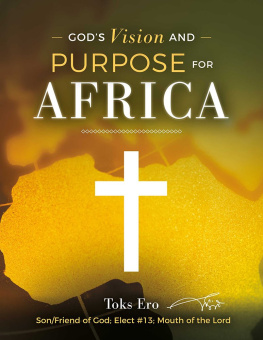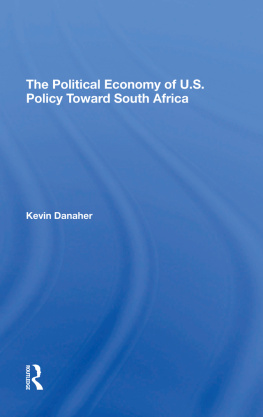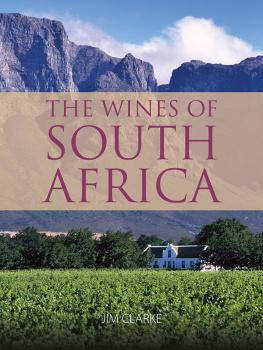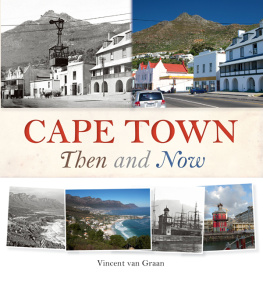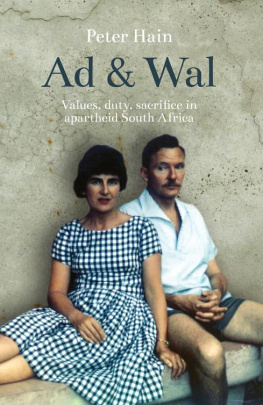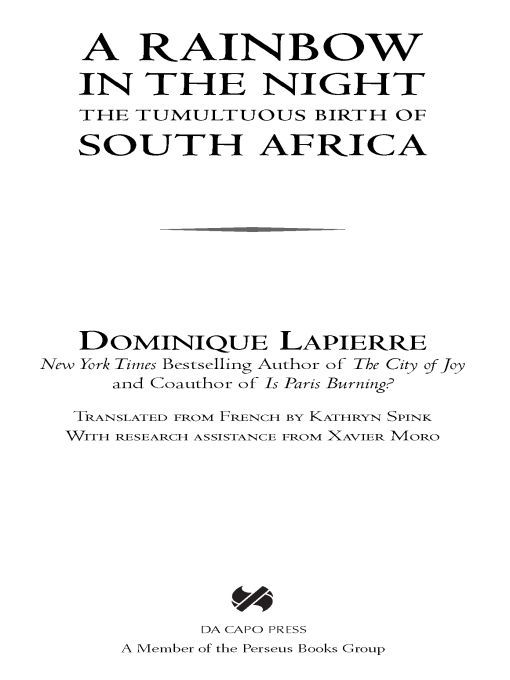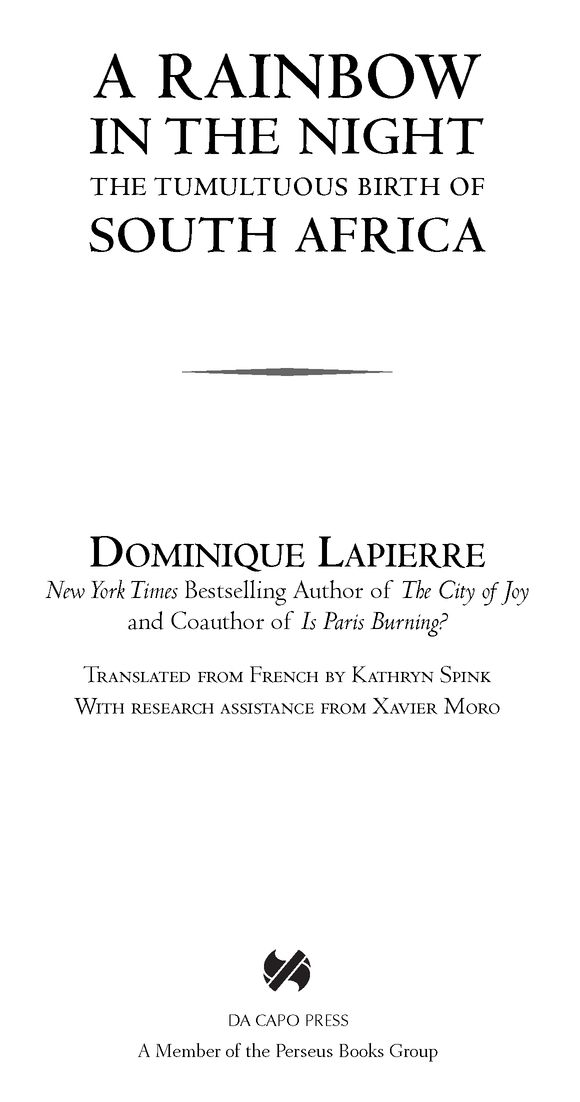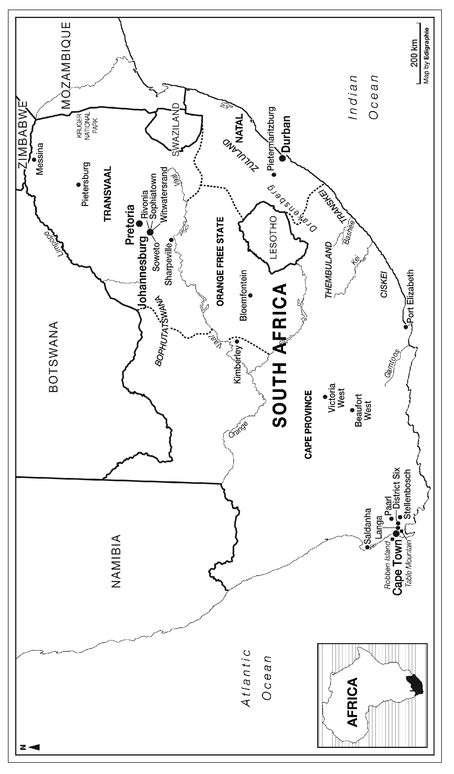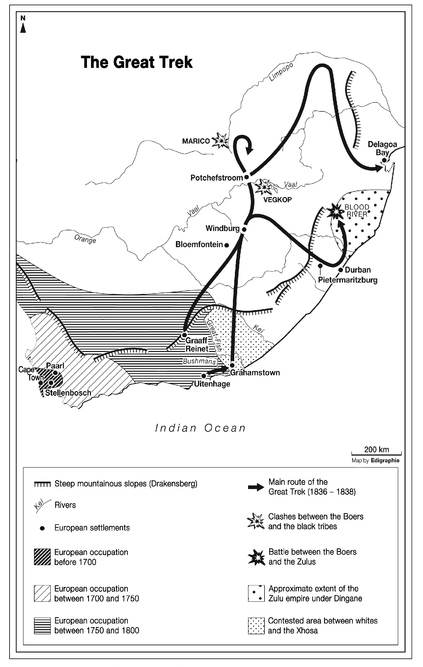Table of Contents
By Dominique Lapierre
Once upon a Time in The Soviet Union
A Thousand Suns
Beyond Love
The City of Joy
By Dominique Lapierre and Xavier Moro
Five Past Midnight in Bhopal
By Dominique Lapierre and Larry Collins
Is New York Burning?
The Fifth Horseman
Freedom at Midnight
O Jerusalem
... Or Ill Dress You in Mourning
Is Paris Burning?
To Helen Lieberman and to all thosewhites, blacks, and coloredswho put an end to apartheid oppression and brought about the triumph of freedom, unity, truth, and reconciliation
AUTHORS NOTE
WHEN I WROTE A Rainbow in the Night, I did not set out to compile an exhaustive history of South Africa. Rather, I wanted to recount, as accurately as possible, a powerful human epic. Much of the information contained in this book is the product of extensive personal research and has not been published previously. I would like to point out, however, that to make the account more vivid, I have chosen to dramatize the proceedings of a secret meeting among the architects of apartheid. This reconstruction is nevertheless based on the historical record and grounded in careful research. For additional information on my sources and a list of selected readings on South Africa, please refer to the bibliography at the end of the book.
D. L.
Each one of us is as intimately attached to the soil of this beautiful country as are the famous jacaranda trees of Pretoria and the mimosa trees of the bushweld... a rainbow nation at peace with itself and the world.
NELSON MANDELA
One
In Search of a New Promised Land
PILLAGE, RAPE, MURDER: it was a sixteenth-century crusade against heresy so violent it was almost unique in history. Hollands northern provinces were engulfed in flames and blood, occupied by savage troops sent from pious Spain. Day and night, the stakes burned thousands who followed the new religion preached by the monk Martin Luther, who had just made his stand against Rome and its avaricious pope. Luthers revolt was swiftly followed by another, spread by an austere, long-nosed Picardian with a goatee and a tight fur collar. From his refuge in Geneva, the theologian John Calvin sent out hundreds of thousands of copies of his manifesto seeking to make the Bible recognized as the unique source of faith and as revealing that God had expressly chosen certain people to have dominion over the whole of creation.
The Bible! For men and women in the Dutch lowlands trying to wrest their freedom from the papist legions, it was already their beacon. And now came messengers from Geneva informing them that they were the new children of Israel, chosen by God to liberate their land, as the Hebrews had once won the land of Canaan. Nothing could have strengthened their will to survive more than this affirmation that they belonged to a chosen people. For you are a people holy unto the Lord! Thou shalt not be affrighted for the Lord thy God is among you... His angel is fighting at your side! recited the bearded iconoclasts emissaries in the churches that had been hastily turned into Protestant places of worship. Citing the Holy Scriptures, they told the rebels that after their subjection to the Spanish crown and the papal tiara, they were now ready, like the patriarchs of the twelve tribes of Israel, to conquer their promised land. If Yahweh has chosen you, they proclaimed, it is not because you are the most populous race on earth, but because you are the smallest. Then, quoting Deuteronomy, they exclaimed, Every place whereon the soles of your feet shall tread shall be yours, and there shall be your frontier.
Twenty centuries earlier God had sent the emperor Cyrus to release the Jews from captivity in Babylon. Now God sent William of Orange to liberate his captive people in the Dutch provinces. In half the time it took Joshua to seize the promised land, the Calvinist William rid his new homeland of its Spanish tyrants, transforming seven modest provinces into a vibrant republic and one of the worlds most modern and powerful states. The prophet Calvin had not been mistaken. God had indeed chosen little Holland for a privileged destiny. The Batavian people would remember this grace for centuries until the day when their descendants, condemned to survive amid other people, would commit one of the greatest crimes in history. But in the early 1600s that fateful moment was still far off. Blessed is he whose transgression is forgiven, the psalm reassured the new Dutch Reformed Church congregations. Along the North Sea coast, in the lowlands and towns of Zeeland and Frisia, a golden age was about to dawn, and Amsterdam was its New Jerusalem. In less than twenty years Hollands capital would become the cultural, artistic, and financial center of Europe. Stimulated by the spiritual and intellectual energy drawn from biblical texts and Calvins writings, it was open to all cultures, all trades, and all religions. Masterpieces (and what masterpieces!) soon evoked this era of vibrant optimism, reflected in the powerful canvases of Rembrandt, Frans Hals, Vermeer, and Bruegel. Life in Dutch society may have continued to bear the stamp of Calvinist Puritanism, but the austere facades of the new patrician dwellings concealed unequalled luxury. The somber clothing seemed to exclude all frivolity but was belied by the sumptuous silk and satin fabrics worn by the notables of the capital.
The small republics economic prosperity became evident as large companies were established through the issuing of stock. The Dutch East India Company, founded in 1602, secured a monopoly on trade throughout Asia, especially in spicescloves, cinnamon, and pepper in particular. It was granted the right to open trading posts, deal with local rulers, and install armed forces wherever it wished to establish itself. Soon amassing 150 merchant vessels and some 40 warships, the Company became a state within the state that had absolute control over the greatest trading enterprise of its day. Its directors were a council of seventeen lords in black satin doublets and white silk collarettes, the Heeren XVII. Their headquarters was an imposing patrician-style building on the banks of the Kloveniers Burgwal canal. In the year 1653 alone, the value of the cargo they traded exceeded the budget for Louis XIVs France.
This commercial supremacy allowed Holland to enrich itself through colonial conquest. In 1651 the maps on the walls of the Council of Seventeens chamber showed no shortage of territory to colonize, whether in Africa, America, or even Asia. A people reminded every Sunday of their God-given exceptional destiny did not question setting off to occupy some other corner of the globe, as they did when they seized the island of Manhattan and founded the city of New Amsterdam. To what new destination and on what mission would the Heeren XVIIs caravels be headed at the end of that year 1651?
An energetic fellow, over six feet two, dressed in a sober black woolen doublet with an embroidered white collar, was about to find out. With a thick shock of brown curls falling onto his shoulders and a determined look under a wide forehead and bushy eyebrows, thirty-three-year-old Jan van Riebeeck exemplified the kind of adventurer Frans Hals liked to paint. The son of a renowned Amsterdam surgeon and a qualified surgeon himself, he had put down his forceps and scalpels to travel the world with his wife, Maria, and their children in the service of the Company. The Seventeen had just recalled him from his post as chief administrator in the Indonesian city of Batavia, which he had helped to found. They had new ambitious plans for their protg. Jan van Riebeeck was thrilled to be setting off on another adventure. Having read the Bible and listened to Calvins prophecies with patriotic fervor, he was ready to serve his countrys grand designs. Ask of me and I will make the nations your heritage, the psalmist assured. The young Dutchman had no doubt that cold morning in December 1651: the Council of Lords would send him on a mission of conquest.


